Challenges in Human Resource Management in Hospitality and Tourism Industry
VerifiedAdded on 2023/06/13
|11
|2934
|160
AI Summary
This essay analyses the different challenges faced by hospitality and tourism venues in the future regarding human resource management. It highlights the war for talent and suggests appropriate approaches to retain and attract key personnel. The major challenges related to human resource management personnel have been analysed effectively. The essay also suggests appropriate changes for gaining success in business.
Contribute Materials
Your contribution can guide someone’s learning journey. Share your
documents today.
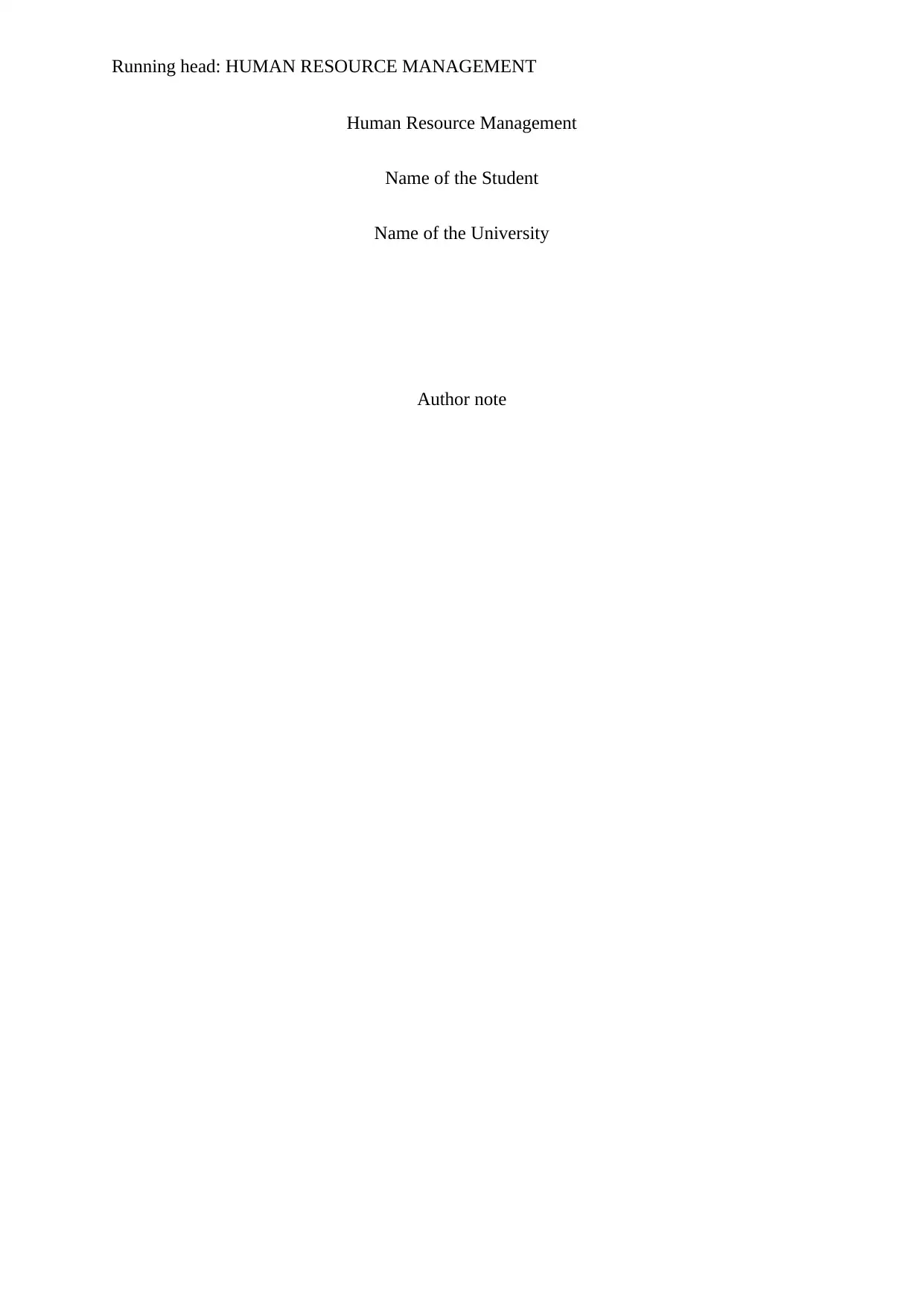
Running head: HUMAN RESOURCE MANAGEMENT
Human Resource Management
Name of the Student
Name of the University
Author note
Human Resource Management
Name of the Student
Name of the University
Author note
Secure Best Marks with AI Grader
Need help grading? Try our AI Grader for instant feedback on your assignments.

1HUMAN RESOURCE MANAGEMENT
Introduction
The essay helps in analysing the different kind of challenges that will be faced by
hospitality and tourism venues in the future regarding the human resource management.
Proper highlight has to be provided to the war for talent that can affect the different initiatives
along with policies that has to be adopted by the companies in order to retain and attract the
key personnel.
The main aim and purpose of the essay is to discuss the major challenges with the
analysis of the appropriate approaches as this will help in ensuring business success. The
challenges related to human resource management personnel has to be analysed effectively as
this will help in solving the different issues effectually.
The structure of the essay includes the major challenges wherein the analysis of the
appropriate approaches has to be analysed effectively. The success of the business is required
to be done as this will help in solving such issues effectively.
About hospitality and tourism venues
The hospitality and tourism management programs are essential in nature and it is one
of the vast industries in the entire world as well. Proper venues of hospitality and tourism
industry is essential in nature as this will help in development of the economy of the country.
There are three different segments in the hospitality and tourism management that includes
the food and beverages, lodging and recreation. The main purpose of tourism industry is to
include leisure of the individuals in the entire world (Agarwal & Islam, 2015).
War for Talent in hospitality and tourism industry
There is huge war for talent in the entire hospitality and tourism industry wherein it
refers to the increasingly competitive landscape for the retaining and recruitment of the
Introduction
The essay helps in analysing the different kind of challenges that will be faced by
hospitality and tourism venues in the future regarding the human resource management.
Proper highlight has to be provided to the war for talent that can affect the different initiatives
along with policies that has to be adopted by the companies in order to retain and attract the
key personnel.
The main aim and purpose of the essay is to discuss the major challenges with the
analysis of the appropriate approaches as this will help in ensuring business success. The
challenges related to human resource management personnel has to be analysed effectively as
this will help in solving the different issues effectually.
The structure of the essay includes the major challenges wherein the analysis of the
appropriate approaches has to be analysed effectively. The success of the business is required
to be done as this will help in solving such issues effectively.
About hospitality and tourism venues
The hospitality and tourism management programs are essential in nature and it is one
of the vast industries in the entire world as well. Proper venues of hospitality and tourism
industry is essential in nature as this will help in development of the economy of the country.
There are three different segments in the hospitality and tourism management that includes
the food and beverages, lodging and recreation. The main purpose of tourism industry is to
include leisure of the individuals in the entire world (Agarwal & Islam, 2015).
War for Talent in hospitality and tourism industry
There is huge war for talent in the entire hospitality and tourism industry wherein it
refers to the increasingly competitive landscape for the retaining and recruitment of the
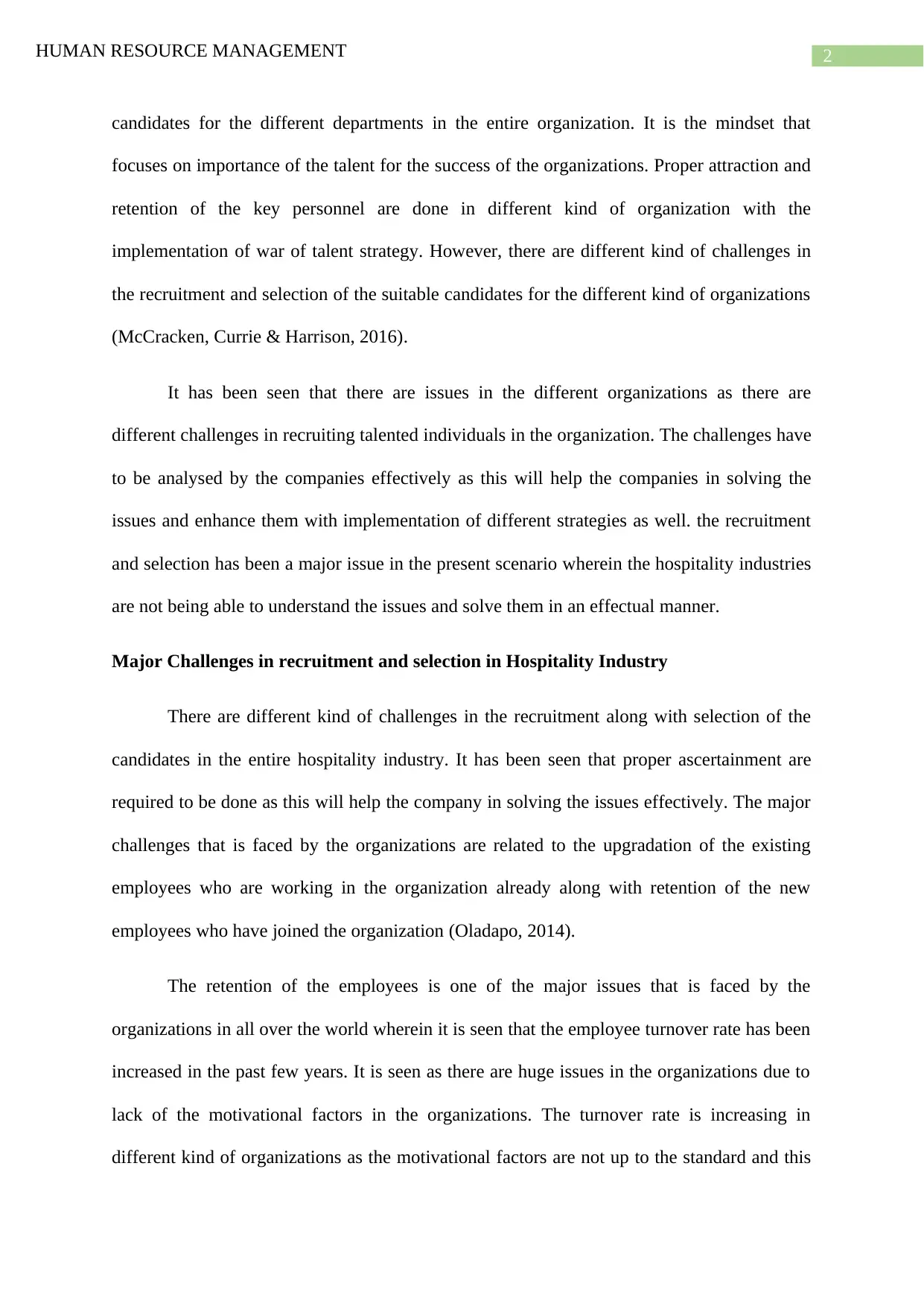
2HUMAN RESOURCE MANAGEMENT
candidates for the different departments in the entire organization. It is the mindset that
focuses on importance of the talent for the success of the organizations. Proper attraction and
retention of the key personnel are done in different kind of organization with the
implementation of war of talent strategy. However, there are different kind of challenges in
the recruitment and selection of the suitable candidates for the different kind of organizations
(McCracken, Currie & Harrison, 2016).
It has been seen that there are issues in the different organizations as there are
different challenges in recruiting talented individuals in the organization. The challenges have
to be analysed by the companies effectively as this will help the companies in solving the
issues and enhance them with implementation of different strategies as well. the recruitment
and selection has been a major issue in the present scenario wherein the hospitality industries
are not being able to understand the issues and solve them in an effectual manner.
Major Challenges in recruitment and selection in Hospitality Industry
There are different kind of challenges in the recruitment along with selection of the
candidates in the entire hospitality industry. It has been seen that proper ascertainment are
required to be done as this will help the company in solving the issues effectively. The major
challenges that is faced by the organizations are related to the upgradation of the existing
employees who are working in the organization already along with retention of the new
employees who have joined the organization (Oladapo, 2014).
The retention of the employees is one of the major issues that is faced by the
organizations in all over the world wherein it is seen that the employee turnover rate has been
increased in the past few years. It is seen as there are huge issues in the organizations due to
lack of the motivational factors in the organizations. The turnover rate is increasing in
different kind of organizations as the motivational factors are not up to the standard and this
candidates for the different departments in the entire organization. It is the mindset that
focuses on importance of the talent for the success of the organizations. Proper attraction and
retention of the key personnel are done in different kind of organization with the
implementation of war of talent strategy. However, there are different kind of challenges in
the recruitment and selection of the suitable candidates for the different kind of organizations
(McCracken, Currie & Harrison, 2016).
It has been seen that there are issues in the different organizations as there are
different challenges in recruiting talented individuals in the organization. The challenges have
to be analysed by the companies effectively as this will help the companies in solving the
issues and enhance them with implementation of different strategies as well. the recruitment
and selection has been a major issue in the present scenario wherein the hospitality industries
are not being able to understand the issues and solve them in an effectual manner.
Major Challenges in recruitment and selection in Hospitality Industry
There are different kind of challenges in the recruitment along with selection of the
candidates in the entire hospitality industry. It has been seen that proper ascertainment are
required to be done as this will help the company in solving the issues effectively. The major
challenges that is faced by the organizations are related to the upgradation of the existing
employees who are working in the organization already along with retention of the new
employees who have joined the organization (Oladapo, 2014).
The retention of the employees is one of the major issues that is faced by the
organizations in all over the world wherein it is seen that the employee turnover rate has been
increased in the past few years. It is seen as there are huge issues in the organizations due to
lack of the motivational factors in the organizations. The turnover rate is increasing in
different kind of organizations as the motivational factors are not up to the standard and this
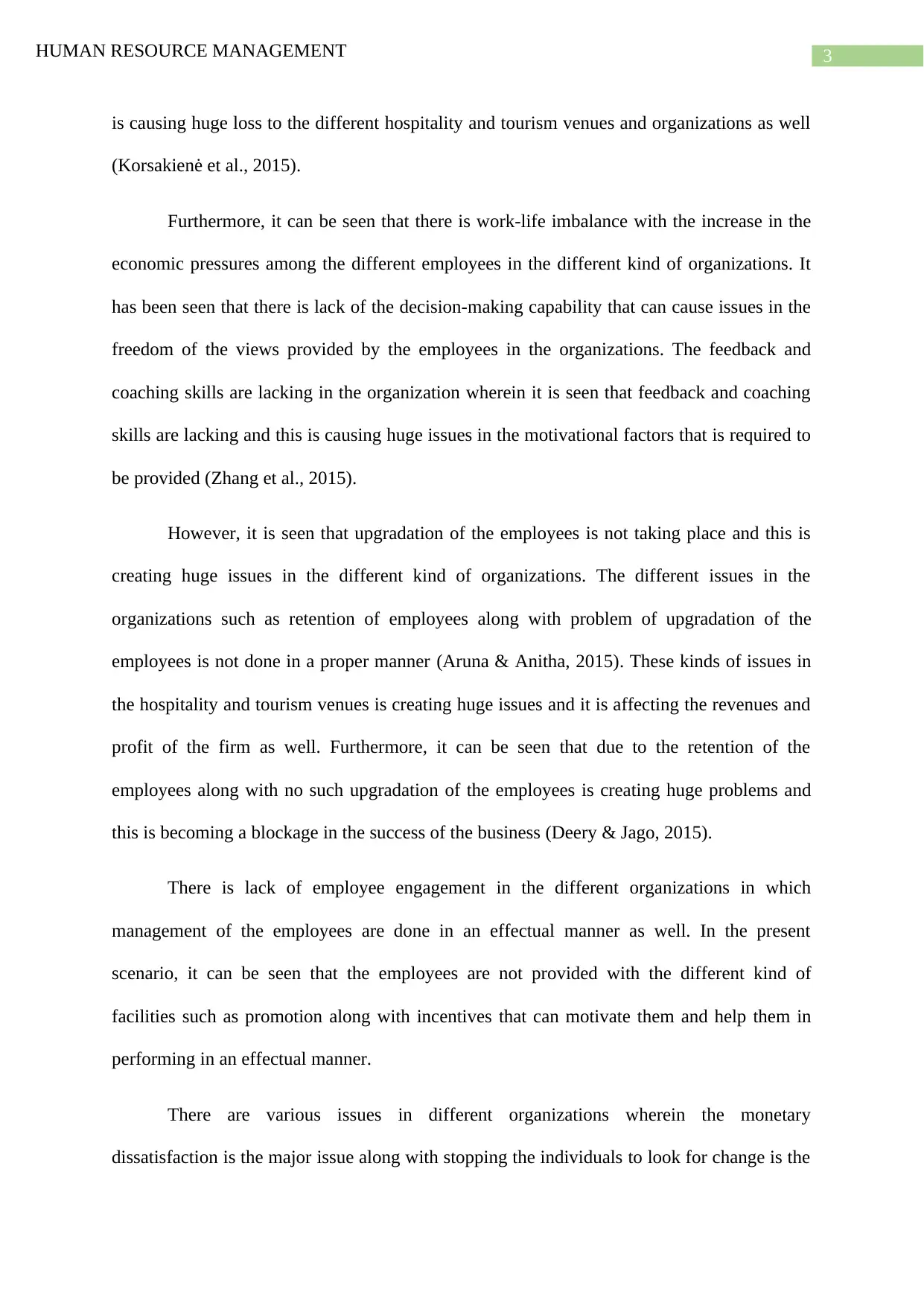
3HUMAN RESOURCE MANAGEMENT
is causing huge loss to the different hospitality and tourism venues and organizations as well
(Korsakienė et al., 2015).
Furthermore, it can be seen that there is work-life imbalance with the increase in the
economic pressures among the different employees in the different kind of organizations. It
has been seen that there is lack of the decision-making capability that can cause issues in the
freedom of the views provided by the employees in the organizations. The feedback and
coaching skills are lacking in the organization wherein it is seen that feedback and coaching
skills are lacking and this is causing huge issues in the motivational factors that is required to
be provided (Zhang et al., 2015).
However, it is seen that upgradation of the employees is not taking place and this is
creating huge issues in the different kind of organizations. The different issues in the
organizations such as retention of employees along with problem of upgradation of the
employees is not done in a proper manner (Aruna & Anitha, 2015). These kinds of issues in
the hospitality and tourism venues is creating huge issues and it is affecting the revenues and
profit of the firm as well. Furthermore, it can be seen that due to the retention of the
employees along with no such upgradation of the employees is creating huge problems and
this is becoming a blockage in the success of the business (Deery & Jago, 2015).
There is lack of employee engagement in the different organizations in which
management of the employees are done in an effectual manner as well. In the present
scenario, it can be seen that the employees are not provided with the different kind of
facilities such as promotion along with incentives that can motivate them and help them in
performing in an effectual manner.
There are various issues in different organizations wherein the monetary
dissatisfaction is the major issue along with stopping the individuals to look for change is the
is causing huge loss to the different hospitality and tourism venues and organizations as well
(Korsakienė et al., 2015).
Furthermore, it can be seen that there is work-life imbalance with the increase in the
economic pressures among the different employees in the different kind of organizations. It
has been seen that there is lack of the decision-making capability that can cause issues in the
freedom of the views provided by the employees in the organizations. The feedback and
coaching skills are lacking in the organization wherein it is seen that feedback and coaching
skills are lacking and this is causing huge issues in the motivational factors that is required to
be provided (Zhang et al., 2015).
However, it is seen that upgradation of the employees is not taking place and this is
creating huge issues in the different kind of organizations. The different issues in the
organizations such as retention of employees along with problem of upgradation of the
employees is not done in a proper manner (Aruna & Anitha, 2015). These kinds of issues in
the hospitality and tourism venues is creating huge issues and it is affecting the revenues and
profit of the firm as well. Furthermore, it can be seen that due to the retention of the
employees along with no such upgradation of the employees is creating huge problems and
this is becoming a blockage in the success of the business (Deery & Jago, 2015).
There is lack of employee engagement in the different organizations in which
management of the employees are done in an effectual manner as well. In the present
scenario, it can be seen that the employees are not provided with the different kind of
facilities such as promotion along with incentives that can motivate them and help them in
performing in an effectual manner.
There are various issues in different organizations wherein the monetary
dissatisfaction is the major issue along with stopping the individuals to look for change is the
Secure Best Marks with AI Grader
Need help grading? Try our AI Grader for instant feedback on your assignments.
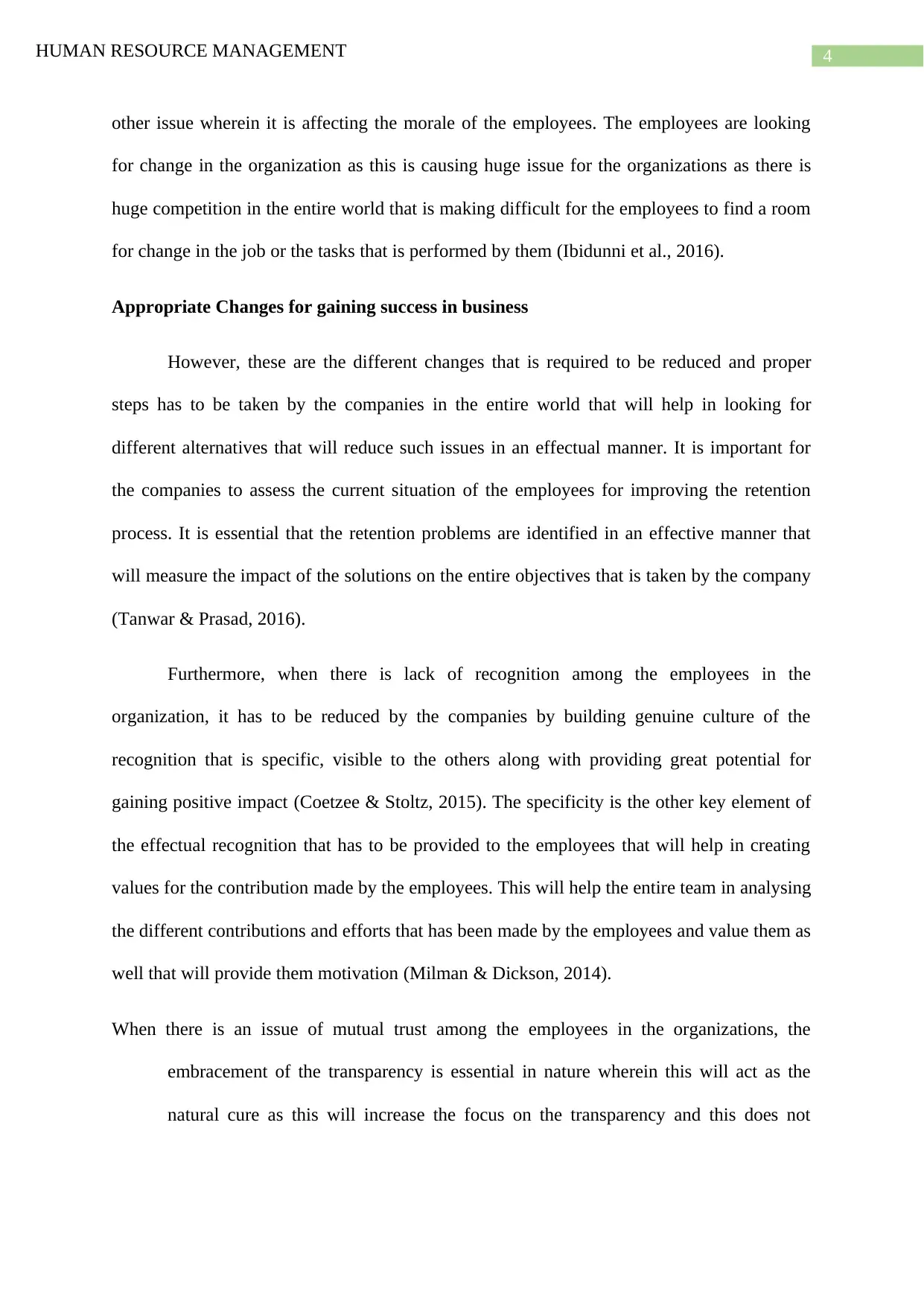
4HUMAN RESOURCE MANAGEMENT
other issue wherein it is affecting the morale of the employees. The employees are looking
for change in the organization as this is causing huge issue for the organizations as there is
huge competition in the entire world that is making difficult for the employees to find a room
for change in the job or the tasks that is performed by them (Ibidunni et al., 2016).
Appropriate Changes for gaining success in business
However, these are the different changes that is required to be reduced and proper
steps has to be taken by the companies in the entire world that will help in looking for
different alternatives that will reduce such issues in an effectual manner. It is important for
the companies to assess the current situation of the employees for improving the retention
process. It is essential that the retention problems are identified in an effective manner that
will measure the impact of the solutions on the entire objectives that is taken by the company
(Tanwar & Prasad, 2016).
Furthermore, when there is lack of recognition among the employees in the
organization, it has to be reduced by the companies by building genuine culture of the
recognition that is specific, visible to the others along with providing great potential for
gaining positive impact (Coetzee & Stoltz, 2015). The specificity is the other key element of
the effectual recognition that has to be provided to the employees that will help in creating
values for the contribution made by the employees. This will help the entire team in analysing
the different contributions and efforts that has been made by the employees and value them as
well that will provide them motivation (Milman & Dickson, 2014).
When there is an issue of mutual trust among the employees in the organizations, the
embracement of the transparency is essential in nature wherein this will act as the
natural cure as this will increase the focus on the transparency and this does not
other issue wherein it is affecting the morale of the employees. The employees are looking
for change in the organization as this is causing huge issue for the organizations as there is
huge competition in the entire world that is making difficult for the employees to find a room
for change in the job or the tasks that is performed by them (Ibidunni et al., 2016).
Appropriate Changes for gaining success in business
However, these are the different changes that is required to be reduced and proper
steps has to be taken by the companies in the entire world that will help in looking for
different alternatives that will reduce such issues in an effectual manner. It is important for
the companies to assess the current situation of the employees for improving the retention
process. It is essential that the retention problems are identified in an effective manner that
will measure the impact of the solutions on the entire objectives that is taken by the company
(Tanwar & Prasad, 2016).
Furthermore, when there is lack of recognition among the employees in the
organization, it has to be reduced by the companies by building genuine culture of the
recognition that is specific, visible to the others along with providing great potential for
gaining positive impact (Coetzee & Stoltz, 2015). The specificity is the other key element of
the effectual recognition that has to be provided to the employees that will help in creating
values for the contribution made by the employees. This will help the entire team in analysing
the different contributions and efforts that has been made by the employees and value them as
well that will provide them motivation (Milman & Dickson, 2014).
When there is an issue of mutual trust among the employees in the organizations, the
embracement of the transparency is essential in nature wherein this will act as the
natural cure as this will increase the focus on the transparency and this does not
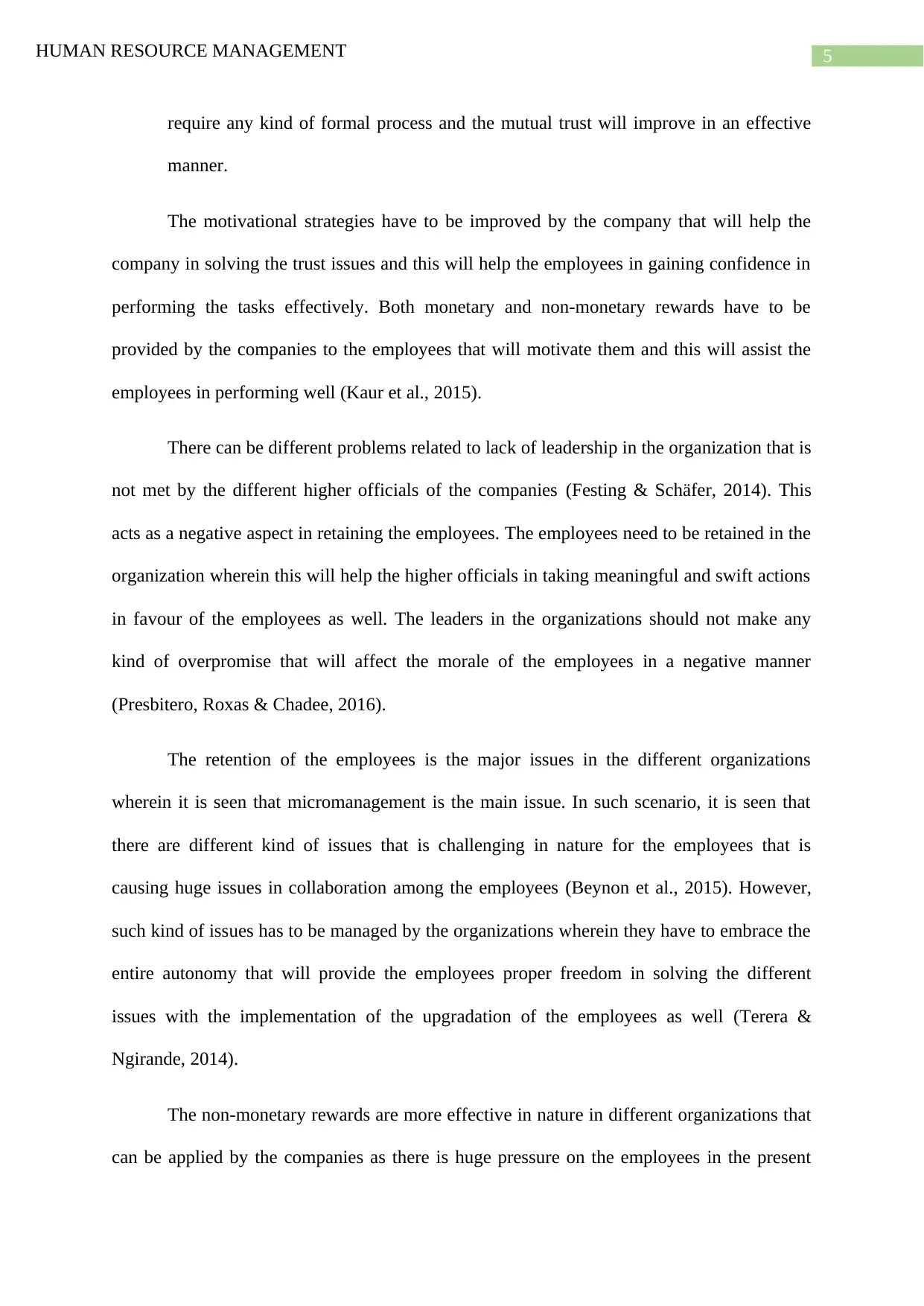
5HUMAN RESOURCE MANAGEMENT
require any kind of formal process and the mutual trust will improve in an effective
manner.
The motivational strategies have to be improved by the company that will help the
company in solving the trust issues and this will help the employees in gaining confidence in
performing the tasks effectively. Both monetary and non-monetary rewards have to be
provided by the companies to the employees that will motivate them and this will assist the
employees in performing well (Kaur et al., 2015).
There can be different problems related to lack of leadership in the organization that is
not met by the different higher officials of the companies (Festing & Schäfer, 2014). This
acts as a negative aspect in retaining the employees. The employees need to be retained in the
organization wherein this will help the higher officials in taking meaningful and swift actions
in favour of the employees as well. The leaders in the organizations should not make any
kind of overpromise that will affect the morale of the employees in a negative manner
(Presbitero, Roxas & Chadee, 2016).
The retention of the employees is the major issues in the different organizations
wherein it is seen that micromanagement is the main issue. In such scenario, it is seen that
there are different kind of issues that is challenging in nature for the employees that is
causing huge issues in collaboration among the employees (Beynon et al., 2015). However,
such kind of issues has to be managed by the organizations wherein they have to embrace the
entire autonomy that will provide the employees proper freedom in solving the different
issues with the implementation of the upgradation of the employees as well (Terera &
Ngirande, 2014).
The non-monetary rewards are more effective in nature in different organizations that
can be applied by the companies as there is huge pressure on the employees in the present
require any kind of formal process and the mutual trust will improve in an effective
manner.
The motivational strategies have to be improved by the company that will help the
company in solving the trust issues and this will help the employees in gaining confidence in
performing the tasks effectively. Both monetary and non-monetary rewards have to be
provided by the companies to the employees that will motivate them and this will assist the
employees in performing well (Kaur et al., 2015).
There can be different problems related to lack of leadership in the organization that is
not met by the different higher officials of the companies (Festing & Schäfer, 2014). This
acts as a negative aspect in retaining the employees. The employees need to be retained in the
organization wherein this will help the higher officials in taking meaningful and swift actions
in favour of the employees as well. The leaders in the organizations should not make any
kind of overpromise that will affect the morale of the employees in a negative manner
(Presbitero, Roxas & Chadee, 2016).
The retention of the employees is the major issues in the different organizations
wherein it is seen that micromanagement is the main issue. In such scenario, it is seen that
there are different kind of issues that is challenging in nature for the employees that is
causing huge issues in collaboration among the employees (Beynon et al., 2015). However,
such kind of issues has to be managed by the organizations wherein they have to embrace the
entire autonomy that will provide the employees proper freedom in solving the different
issues with the implementation of the upgradation of the employees as well (Terera &
Ngirande, 2014).
The non-monetary rewards are more effective in nature in different organizations that
can be applied by the companies as there is huge pressure on the employees in the present
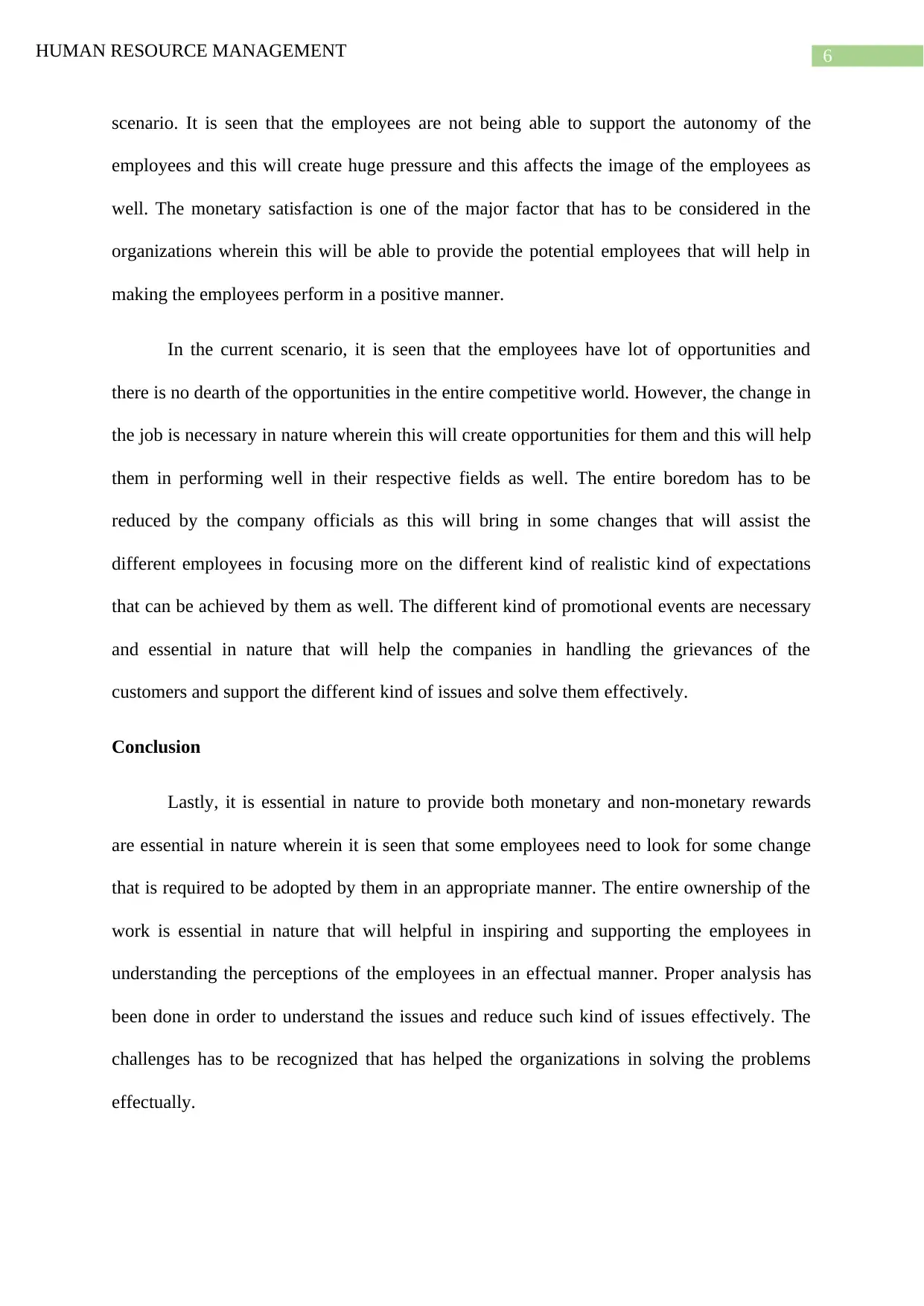
6HUMAN RESOURCE MANAGEMENT
scenario. It is seen that the employees are not being able to support the autonomy of the
employees and this will create huge pressure and this affects the image of the employees as
well. The monetary satisfaction is one of the major factor that has to be considered in the
organizations wherein this will be able to provide the potential employees that will help in
making the employees perform in a positive manner.
In the current scenario, it is seen that the employees have lot of opportunities and
there is no dearth of the opportunities in the entire competitive world. However, the change in
the job is necessary in nature wherein this will create opportunities for them and this will help
them in performing well in their respective fields as well. The entire boredom has to be
reduced by the company officials as this will bring in some changes that will assist the
different employees in focusing more on the different kind of realistic kind of expectations
that can be achieved by them as well. The different kind of promotional events are necessary
and essential in nature that will help the companies in handling the grievances of the
customers and support the different kind of issues and solve them effectively.
Conclusion
Lastly, it is essential in nature to provide both monetary and non-monetary rewards
are essential in nature wherein it is seen that some employees need to look for some change
that is required to be adopted by them in an appropriate manner. The entire ownership of the
work is essential in nature that will helpful in inspiring and supporting the employees in
understanding the perceptions of the employees in an effectual manner. Proper analysis has
been done in order to understand the issues and reduce such kind of issues effectively. The
challenges has to be recognized that has helped the organizations in solving the problems
effectually.
scenario. It is seen that the employees are not being able to support the autonomy of the
employees and this will create huge pressure and this affects the image of the employees as
well. The monetary satisfaction is one of the major factor that has to be considered in the
organizations wherein this will be able to provide the potential employees that will help in
making the employees perform in a positive manner.
In the current scenario, it is seen that the employees have lot of opportunities and
there is no dearth of the opportunities in the entire competitive world. However, the change in
the job is necessary in nature wherein this will create opportunities for them and this will help
them in performing well in their respective fields as well. The entire boredom has to be
reduced by the company officials as this will bring in some changes that will assist the
different employees in focusing more on the different kind of realistic kind of expectations
that can be achieved by them as well. The different kind of promotional events are necessary
and essential in nature that will help the companies in handling the grievances of the
customers and support the different kind of issues and solve them effectively.
Conclusion
Lastly, it is essential in nature to provide both monetary and non-monetary rewards
are essential in nature wherein it is seen that some employees need to look for some change
that is required to be adopted by them in an appropriate manner. The entire ownership of the
work is essential in nature that will helpful in inspiring and supporting the employees in
understanding the perceptions of the employees in an effectual manner. Proper analysis has
been done in order to understand the issues and reduce such kind of issues effectively. The
challenges has to be recognized that has helped the organizations in solving the problems
effectually.
Paraphrase This Document
Need a fresh take? Get an instant paraphrase of this document with our AI Paraphraser
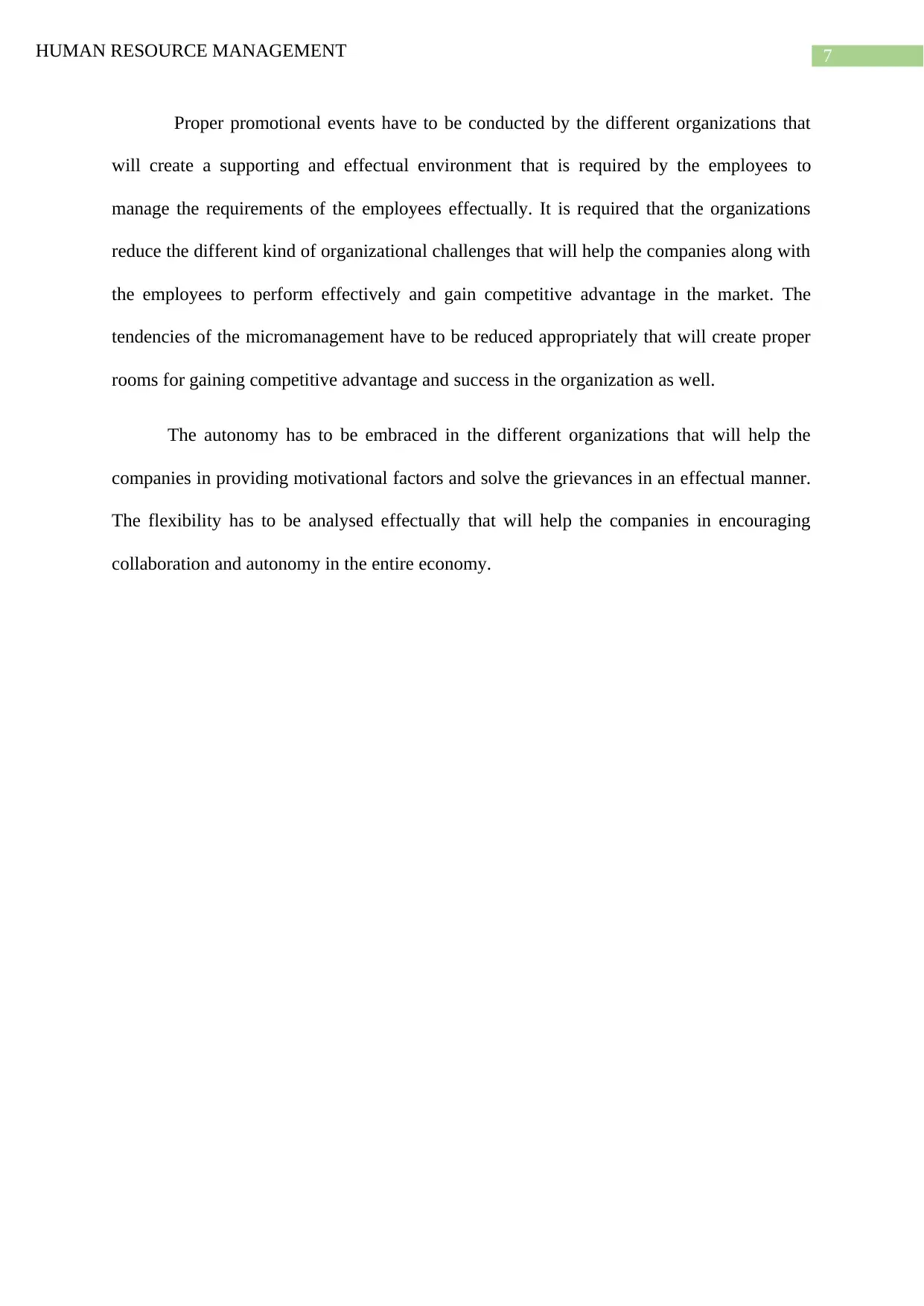
7HUMAN RESOURCE MANAGEMENT
Proper promotional events have to be conducted by the different organizations that
will create a supporting and effectual environment that is required by the employees to
manage the requirements of the employees effectually. It is required that the organizations
reduce the different kind of organizational challenges that will help the companies along with
the employees to perform effectively and gain competitive advantage in the market. The
tendencies of the micromanagement have to be reduced appropriately that will create proper
rooms for gaining competitive advantage and success in the organization as well.
The autonomy has to be embraced in the different organizations that will help the
companies in providing motivational factors and solve the grievances in an effectual manner.
The flexibility has to be analysed effectually that will help the companies in encouraging
collaboration and autonomy in the entire economy.
Proper promotional events have to be conducted by the different organizations that
will create a supporting and effectual environment that is required by the employees to
manage the requirements of the employees effectually. It is required that the organizations
reduce the different kind of organizational challenges that will help the companies along with
the employees to perform effectively and gain competitive advantage in the market. The
tendencies of the micromanagement have to be reduced appropriately that will create proper
rooms for gaining competitive advantage and success in the organization as well.
The autonomy has to be embraced in the different organizations that will help the
companies in providing motivational factors and solve the grievances in an effectual manner.
The flexibility has to be analysed effectually that will help the companies in encouraging
collaboration and autonomy in the entire economy.
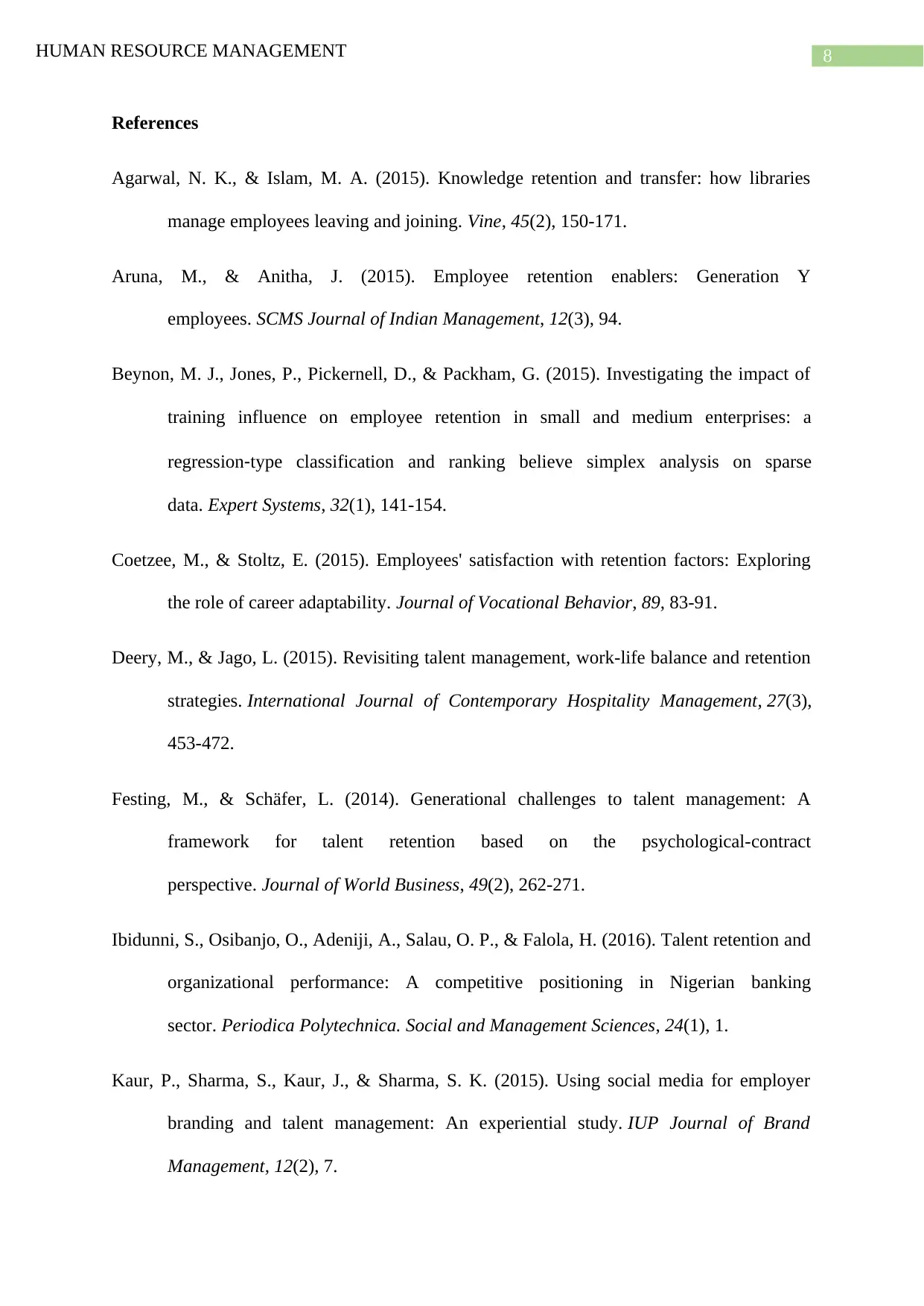
8HUMAN RESOURCE MANAGEMENT
References
Agarwal, N. K., & Islam, M. A. (2015). Knowledge retention and transfer: how libraries
manage employees leaving and joining. Vine, 45(2), 150-171.
Aruna, M., & Anitha, J. (2015). Employee retention enablers: Generation Y
employees. SCMS Journal of Indian Management, 12(3), 94.
Beynon, M. J., Jones, P., Pickernell, D., & Packham, G. (2015). Investigating the impact of
training influence on employee retention in small and medium enterprises: a
regression‐type classification and ranking believe simplex analysis on sparse
data. Expert Systems, 32(1), 141-154.
Coetzee, M., & Stoltz, E. (2015). Employees' satisfaction with retention factors: Exploring
the role of career adaptability. Journal of Vocational Behavior, 89, 83-91.
Deery, M., & Jago, L. (2015). Revisiting talent management, work-life balance and retention
strategies. International Journal of Contemporary Hospitality Management, 27(3),
453-472.
Festing, M., & Schäfer, L. (2014). Generational challenges to talent management: A
framework for talent retention based on the psychological-contract
perspective. Journal of World Business, 49(2), 262-271.
Ibidunni, S., Osibanjo, O., Adeniji, A., Salau, O. P., & Falola, H. (2016). Talent retention and
organizational performance: A competitive positioning in Nigerian banking
sector. Periodica Polytechnica. Social and Management Sciences, 24(1), 1.
Kaur, P., Sharma, S., Kaur, J., & Sharma, S. K. (2015). Using social media for employer
branding and talent management: An experiential study. IUP Journal of Brand
Management, 12(2), 7.
References
Agarwal, N. K., & Islam, M. A. (2015). Knowledge retention and transfer: how libraries
manage employees leaving and joining. Vine, 45(2), 150-171.
Aruna, M., & Anitha, J. (2015). Employee retention enablers: Generation Y
employees. SCMS Journal of Indian Management, 12(3), 94.
Beynon, M. J., Jones, P., Pickernell, D., & Packham, G. (2015). Investigating the impact of
training influence on employee retention in small and medium enterprises: a
regression‐type classification and ranking believe simplex analysis on sparse
data. Expert Systems, 32(1), 141-154.
Coetzee, M., & Stoltz, E. (2015). Employees' satisfaction with retention factors: Exploring
the role of career adaptability. Journal of Vocational Behavior, 89, 83-91.
Deery, M., & Jago, L. (2015). Revisiting talent management, work-life balance and retention
strategies. International Journal of Contemporary Hospitality Management, 27(3),
453-472.
Festing, M., & Schäfer, L. (2014). Generational challenges to talent management: A
framework for talent retention based on the psychological-contract
perspective. Journal of World Business, 49(2), 262-271.
Ibidunni, S., Osibanjo, O., Adeniji, A., Salau, O. P., & Falola, H. (2016). Talent retention and
organizational performance: A competitive positioning in Nigerian banking
sector. Periodica Polytechnica. Social and Management Sciences, 24(1), 1.
Kaur, P., Sharma, S., Kaur, J., & Sharma, S. K. (2015). Using social media for employer
branding and talent management: An experiential study. IUP Journal of Brand
Management, 12(2), 7.
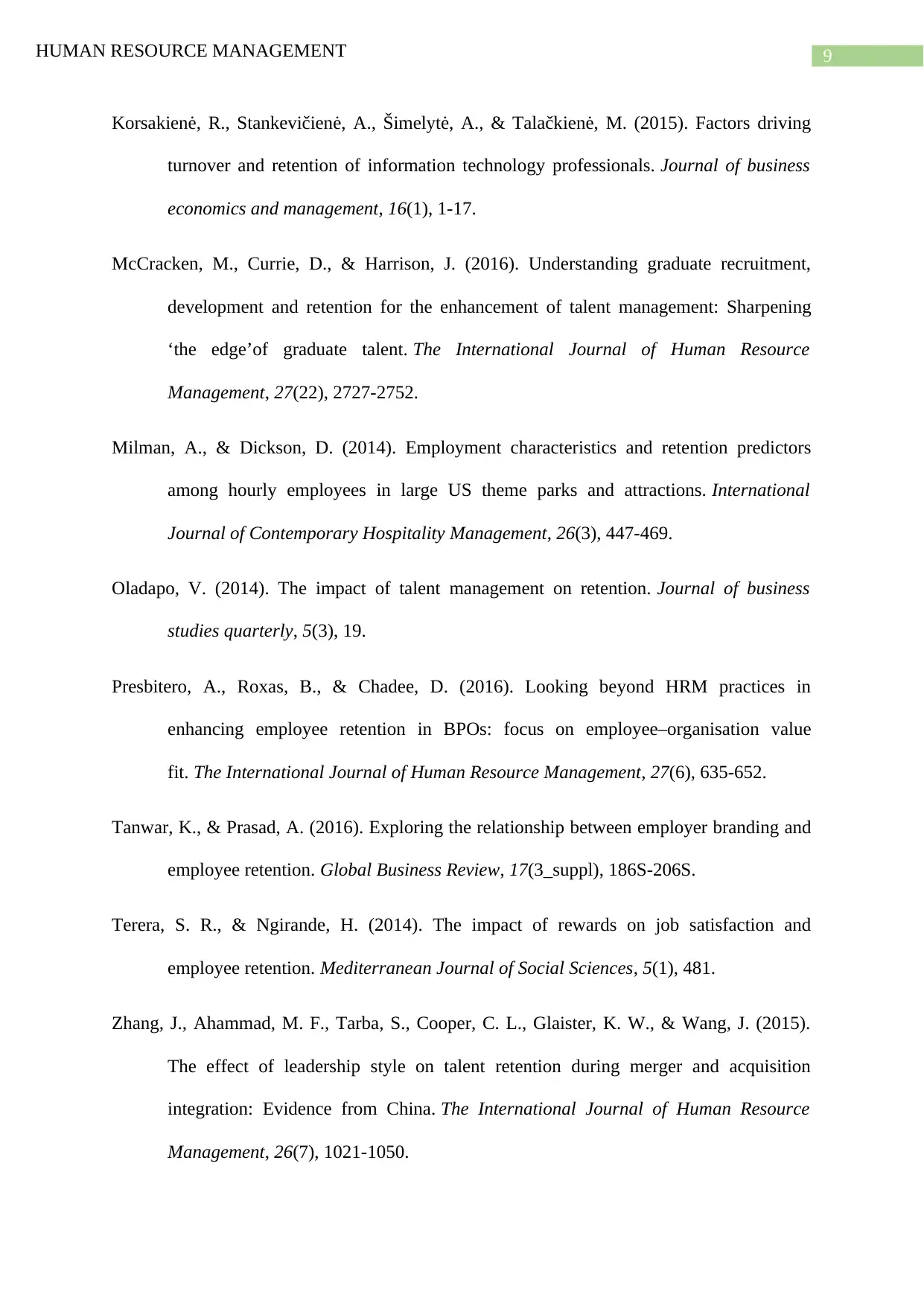
9HUMAN RESOURCE MANAGEMENT
Korsakienė, R., Stankevičienė, A., Šimelytė, A., & Talačkienė, M. (2015). Factors driving
turnover and retention of information technology professionals. Journal of business
economics and management, 16(1), 1-17.
McCracken, M., Currie, D., & Harrison, J. (2016). Understanding graduate recruitment,
development and retention for the enhancement of talent management: Sharpening
‘the edge’of graduate talent. The International Journal of Human Resource
Management, 27(22), 2727-2752.
Milman, A., & Dickson, D. (2014). Employment characteristics and retention predictors
among hourly employees in large US theme parks and attractions. International
Journal of Contemporary Hospitality Management, 26(3), 447-469.
Oladapo, V. (2014). The impact of talent management on retention. Journal of business
studies quarterly, 5(3), 19.
Presbitero, A., Roxas, B., & Chadee, D. (2016). Looking beyond HRM practices in
enhancing employee retention in BPOs: focus on employee–organisation value
fit. The International Journal of Human Resource Management, 27(6), 635-652.
Tanwar, K., & Prasad, A. (2016). Exploring the relationship between employer branding and
employee retention. Global Business Review, 17(3_suppl), 186S-206S.
Terera, S. R., & Ngirande, H. (2014). The impact of rewards on job satisfaction and
employee retention. Mediterranean Journal of Social Sciences, 5(1), 481.
Zhang, J., Ahammad, M. F., Tarba, S., Cooper, C. L., Glaister, K. W., & Wang, J. (2015).
The effect of leadership style on talent retention during merger and acquisition
integration: Evidence from China. The International Journal of Human Resource
Management, 26(7), 1021-1050.
Korsakienė, R., Stankevičienė, A., Šimelytė, A., & Talačkienė, M. (2015). Factors driving
turnover and retention of information technology professionals. Journal of business
economics and management, 16(1), 1-17.
McCracken, M., Currie, D., & Harrison, J. (2016). Understanding graduate recruitment,
development and retention for the enhancement of talent management: Sharpening
‘the edge’of graduate talent. The International Journal of Human Resource
Management, 27(22), 2727-2752.
Milman, A., & Dickson, D. (2014). Employment characteristics and retention predictors
among hourly employees in large US theme parks and attractions. International
Journal of Contemporary Hospitality Management, 26(3), 447-469.
Oladapo, V. (2014). The impact of talent management on retention. Journal of business
studies quarterly, 5(3), 19.
Presbitero, A., Roxas, B., & Chadee, D. (2016). Looking beyond HRM practices in
enhancing employee retention in BPOs: focus on employee–organisation value
fit. The International Journal of Human Resource Management, 27(6), 635-652.
Tanwar, K., & Prasad, A. (2016). Exploring the relationship between employer branding and
employee retention. Global Business Review, 17(3_suppl), 186S-206S.
Terera, S. R., & Ngirande, H. (2014). The impact of rewards on job satisfaction and
employee retention. Mediterranean Journal of Social Sciences, 5(1), 481.
Zhang, J., Ahammad, M. F., Tarba, S., Cooper, C. L., Glaister, K. W., & Wang, J. (2015).
The effect of leadership style on talent retention during merger and acquisition
integration: Evidence from China. The International Journal of Human Resource
Management, 26(7), 1021-1050.
Secure Best Marks with AI Grader
Need help grading? Try our AI Grader for instant feedback on your assignments.
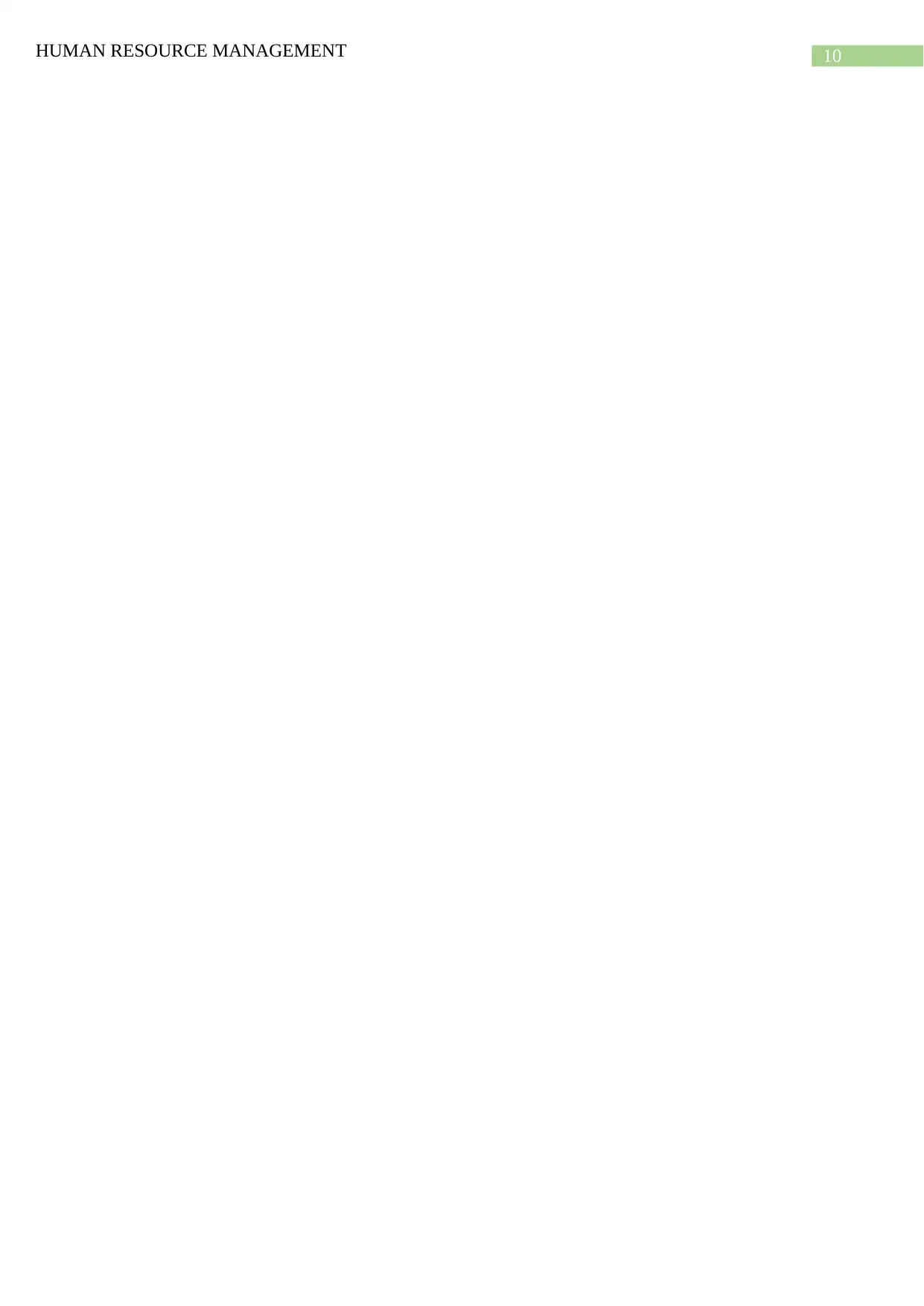
10HUMAN RESOURCE MANAGEMENT
1 out of 11
Related Documents
Your All-in-One AI-Powered Toolkit for Academic Success.
+13062052269
info@desklib.com
Available 24*7 on WhatsApp / Email
![[object Object]](/_next/static/media/star-bottom.7253800d.svg)
Unlock your academic potential
© 2024 | Zucol Services PVT LTD | All rights reserved.





